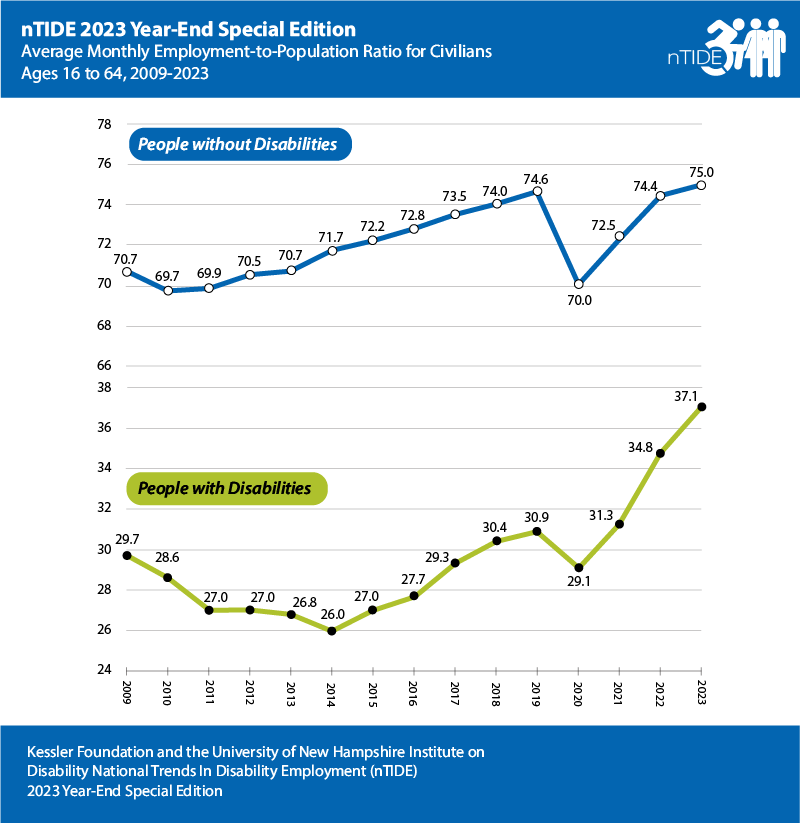National Trends in Disability Employment (nTIDE) 2023 Year-End Special Edition – issued by Kessler Foundation and the University of New Hampshire

East Hanover, NJ – January 30, 2024 – Amidst the backdrop of a remarkable four-year streak of growth, the employment indicators for people with disabilities reached unprecedented milestones in 2023. This achievement stands in stark contrast to the experiences of people without disabilities who faced a more severe decline during the COVID-19 pandemic and a slower recovery, not surpassing their pre-pandemic employment levels until 2023. That’s according to the National Trends in Disability Employment (nTIDE) 2023 Year-End Special Edition, issued by Kessler Foundation and the University of New Hampshire’s Institute on Disability (UNH-IOD), based on data from the U.S. Bureau of Labor Statistics (BLS) Jobs Reports.
These data were reported recently during a recent nTIDE Deeper Dive Lunch & Learn by nTIDE experts Andrew Houtenville, PhD, professor of economics at UNH and research director of the IOD and John O’Neill, PhD, director, Center for Employment and Disability Research at Kessler Foundation.
“These impressive gains prompt many questions,” noted Dr. Houtenville. “How have they achieved these gains when people without disabilities are only now reaching their pre-pandemic level? Are these gains durable? Are we seeing a new normal for workers with disabilities as they compete in an evolving labor market? Are all people with disabilities engaging in the post-pandemic recovery and growth?”
“The sustained surge in employment for individuals with disabilities could be due to several significant employer trends including the 2022-2023 intense labor shortage and a proliferation of job postings and increased wages,” said Dr. Houtenville. “Additionally, the pandemic played a crucial role in popularizing remote work, emphasizing the necessity to enhance accommodations not only for employees with COVID but also for individuals with other disabling conditions,” added Dr. O’Neill.
Employment-to-Population Ratio: 2009 – 2023


While the average monthly employment-to-population ratio increased in 2023 for both people with and without disabilities (ages 16-64), the increases experienced by people with disabilities were far larger. The average monthly employment-to-population ratio for people with disabilities reached a new all-time high in 2023 at 37.1 percent, surpassing the previous record of 34.8 percent in 2022, which had exceeded the prior peak of 31.3 percent in 2021, and even exceeded the pre-pandemic level of 30.9 percent in 2019.
In contrast, the average monthly employment-to-population ratio of people without disabilities increased from 74.4 percent in 2022 to 75.0 percent in 2023, finally surpassing the pre-pandemic level of 74.6 percent in 2019.
The employment-to-population ratio, a key indicator, reflects the percentage of people who are working relative to the total population (the number of people working divided by the number of people in the total population multiplied by 100).
Highlights from 2023 nTIDE Deeper Dives into Sub-Populations
Throughout 2023, nTIDE experts analyzed the contribution of various sub-populations to these historic employment gains for people with disabilities in monthly “Deeper Dive” Lunch & Learn webinars. Although some of these sub-groups were slower than others in rebounding, by 2023, all had reached employment levels above their historic highs,” said Dr. Houtenville. “Clearly, the upward trend for employment for people with disabilities is broad-based,” he added.
- Blacks/African Americans – The intersection of race and disability perpetuate inequalities in employment impacting Black/African American people with disabilities
- Hispanics – Hispanics with disabilities making historic rebound in job market Post-COVID-19 shutdown
- Visual Disabilities – How did Covid-19 lockdown impact employment of individuals with visual disabilities?
- Young Adult Workers – Post-pandemic job recovery highest among young adult workers with disabilities
- Veterans – Veterans with disabilities achieve record highs for employment
Significant Changes in Employer Practices
“The significant changes that took place between 2017 and 2022 regarding employer practices may have also contributed to the employment gains of people with disabilities in 2023,” asserted Dr. O’Neill. He provided an overview of the findings in the 2022 National Employment & Disability Survey: Effects of COVID-19 Pandemic on Supervisor Perspectives conducted by Kessler Foundation and UNH. In addition, hiring and recruiting people with disabilities was more important to supervisors and upper management in 2022 than in 2017, when compared to the findings of the 2017 National Employment & Disability Survey: Supervisor Perspectives.
“The use of flexible work arrangements more than doubled from 2017, with most supervisors predicting that work-from-home options would continue post-pandemic,” he said. “And today, twice as many supervisors work for organizations with a central accommodation fund, which incentivizes hiring and supports the success of people with disabilities in the workplace.”
Recognizing that hiring and training new staff could be costly, employers reported becoming more attuned to the advantages of providing accommodations, especially evident in accommodating employees with COVID and long COVID. “This led to a greater emphasis on providing accommodations not only for COVID-related cases but also for individuals with other disabling conditions,” explained Dr. O’Neill.
Additionally, he highlighted various practices that may have contributed to increased employment rates for people with disabilities. For example, employers started utilizing disability organizations for recruiting, providing training to supervisors on accessible applications and interviewing techniques, and auditing hiring procedures for accessibility. In terms of retention, more employers began offering job sharing, training on disability issues and cultural competence. “These positive changes may underlie the increase in the employment of people with disabilities, although direct causal connections cannot be made,” said Dr. O’Neill.
“This environment creates new job opportunities, often closer to home, making it more appealing for individuals with disabilities to enter the labor force. Achieving these higher levels of employment requires the synergy of both labor demand and labor supply factors,” added Dr. Houtenville. "The expansion of work-from-home possibilities and the greater adaptability in work hours observed during the pandemic's peak could have potentially paved the way for lasting job opportunities for people with disabilities.”
Register now for our upcoming nTIDE webinars scheduled for February 2 and February 16, 2024: nTIDE Lunch & Learn Webinar Series | Center for Research on Disability
NOTE: The statistics in the nTIDE are based on BLS numbers but are not identical. They are customized by UNH to combine the statistics for men and women of working age (16- 64). nTIDE is funded by the National Institute on Disability, Independent Living and Rehabilitation Research (NIDILRR; 90RTGE0005) and Kessler Foundation.
About nTIDE Updates
National Trends in Disability Employment (nTIDE) is a joint project of Kessler Foundation and the University of New Hampshire Institute on Disability. The nTIDE team closely monitors the job numbers, issuing semi-monthly reports that track the impact of economic shifts on employment for people with and without disabilities. As the effect of the COVID-19 pandemic continues to wane and inflation persistently rises, the nTIDE team has superseded its mid-month COVID Update to a “Deeper Dive” into the BLS data for people with disabilities.
About the Institute on Disability at the University of New Hampshire
The Institute on Disability at the University of New Hampshire was established in 1987 to provide a university-based focus for the improvement of knowledge, policies, and practices related to the lives of persons with disabilities and their families. For information on the Intitute’s NIDILRR-funded Rehabilitation Research and Training Center on Disability Statistics and Demographics (StatsRRTC), visit ResearchOnDisability.org
About Kessler Foundation
Kessler Foundation, a major nonprofit organization in the field of disability, is a global leader in rehabilitation research. Our scientists seek to improve cognition, mobility, and long-term outcomes, including employment, for adults and children with neurological and developmental disabilities of the brain and spinal cord including traumatic brain injury, spinal cord injury, stroke, multiple sclerosis, and autism. Kessler Foundation also leads the nation in funding innovative programs that expand opportunities for employment for people with disabilities.